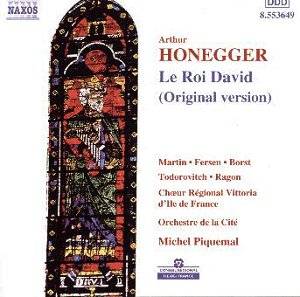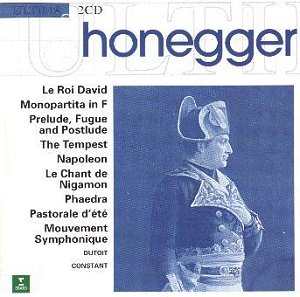
Le Roi David
Honegger wrote his Le Roi David music for René Morax's
Mézières village theatre group in 1908 creating a score for
the resources available: a small ensemble of six woodwind, four brass, a
harmonium, a piano, two timpani, a double bass, a gong and a tam-tam. Little
did Honegger realise how successful the production would be. In fact its
overwhelming popularity (and that of the well-known Pacific 231
representational of the large locomotive) caused him to complain, in later
life, that it overshadowed his large corpus of other works. The precedent
set by this work - or rather the subsequent adaptation of the play into the
form of Symphonic Psalm (a quasi-oratorio format) with narrator - led directly
to another major and highly popular work in the same format, Jeanne d'Arc
au Bûcher (St Joan at the Stake). It is a tribute to Honegger's
resourcefulness how well, and complete, the instrumentation sounds: full
of atmosphere, colour and drama with the limited brass suggesting majesty
and combat most vividly.
There are many opportunities for the soloists and choir (the narrative is
alternated with Psalms) and the narration binds all together.
Le Roi David, cast in three parts, tells the Old Testament story of
the life of David commencing with Samuel, on the Lord's command seeking out
the child shepherd David. The story progresses through David's victory over
Goliath (which is given scant attention) through to David's life at court.
The close friendship of David and Jonathan is covered, and the jealousy of
the ageing Saul that causes David to flee and join the Philistines. Saul
is defeated in battle against them and in the grand concluding set-piece
of Part One, 'Lamentation of Gilboa', David mourns the death, in the battle,
of both Saul and Jonathan. In the shorter Part Two, David is now King and
after a festive song, there is another spectacular set-piece, 'Dance before
the Ark.' Part Three covers David's sinful love for Bathsheba, God's wrath
and the death of their child, David's repentance, the strife in David's family,
and the revolt and death of his son Absalom. In the evening of his years,
David, is scourged by the Lord and having seen Nathan crown his son Solomon
he goes to the temple for the last time…
These two recorded performances are both impressive and both are recommended.
Each has its strong points but they are basically neck-and-neck in overall
quality and impact. Of the two narrators, Jacques Martin (Naxos) is more
expressive, Jean Desailly (Ultima/Erato) more commanding. Christine Fersen's
prophetess, on Naxos, just surpasses Valère, the Ultima soloist in
creepy-witchery. Fersen's - 'Up, up appear Ah!…' as she summons up the
shade of Samuel is blood-curdling indeed. Soprano Danielle Borst impresses
in her Psalm: 'O for the wings of a dove' and the Naxos instrumental interlude
here is particularly memorable with harmonium and oboe creating a sheen of
radiant beauty. The woodwind playing throughout the Naxos performance is
of a very high standard, right from the beginning when they so evocatively
play the sinuous twisting forms and rhythms of the Arabian/Middle Eastern
inflected music. Where Dutoit's players, and I am thinking mostly of the
brass, might have the edge is in the potency of their ceremonial marches
and battle music and they are very successful in the more sardonic, gibing
March of the Philistines. Both choirs shine but the Naxos singers are slightly
ahead especially in the glorious Alleluia's that conclude the magnificent
'Dance before the Ark sequence and end the work. The skimpy notes that come
with the super- budget Ultima set do not include the text and translation
more generously supplied by Naxos which, by a small margin, is my preferred
version.
The supporting works on the Ultima/Erato album (CD-2)
Pastorale d'été (Summer Pastorale) (1920) is
deservedly one of Honegger's most popular works. This simple, unpretentious
yet most beautiful evocation was inspired by a summer holiday at Wengen in
the Bernese Oberland at the foot of the Jungfrau mountain. Over a gently
undulating accompaniment the horn plays a long calm melody. The atmosphere
is dreamy and sultry with birdcalls and later, a simple rustic melody is
introduced. The Debussy of Prélude à l'aprés midi
d'un faune is echoed, and so too is Beethoven's Pastoral Symphony.
Dutoit delivers a lovely evocative rendition and contrasts this with a spirited
and deeply felt reading of Symphonic Movement No.3 (1932-33) for which
the composer offered no programmatic guidance. Its broad sweep anticipates
the symphonies. It begins in a virile and energetic mood with jerky, dissonant
material and I could not help but see a train in my minds eye. The 'heroic'
middle section is one of insolent defiance but the work ends rather gloomily
with the long lament of the Adagio
The remaining works on the disc are conducted by Marius Constant. The
Prelude, Fugue and Postlude from Amphion (1948 from original
composition of 1929) was written during Honegger's convalescence after his
1947 heart attack. It is worth quoting the words at the head of the score:
'Amphion, a man, receives the lyre from Apollo. Music grows from under his
fingers. At the blossoming sounds, the stones move and join together:
architecture is created. As the hero climbs towards the temple, a veiled
female figure appears and bars his way. Amphion hides his face in the bosom
of this figure, who is Love or Death and allows himself to be led off by
her.'
The Prelude begins imposingly and majestically before we hear a lovely pastoral
dialogue on woodwinds that evokes the freshness of morning. Then follows
a fast section in which Honegger uses a veritable feast of scales moving
in all directions and all speeds. The Prelude ends with a restatement of
Amphion's theme. This whole movement is one of radiance and vitality. Honegger's
biographer, Harry Halbreich, describes the Fugue as being "of prodigious
length and Herculean power. In its octave leaps and rhythmic articulation,
it is strongly reminiscent of the Finale of Bruckner's Fifth Symphony also
treated in fugue form." The accumulated tension is very powerful. The brief
postlude presents darker material with a long saxophone cantilever taken
over by the cor anglais around which shadows and pitch continue to fall.
The work is interesting for its use of the saxophone which Honegger normally
reserved for his theatre and film compositions. Monopartita (1951)
a late work was commissioned by Honegger's native city of Zurich. It has
a granite-like grandeur and an intense emotion ih an Adagio that seems to
be a cry from the heart.
Les Ombres (The Shadows) as the title suggests is an evocative
mysterious fragment from Honegger's music (1926-27) for Abel Gance's film
Napoléon. The Prelude for The
Tempest (1923) is a wild, stormy seascape and Constant whips
up a real maelstrom. The composition is notable for the chromatic whistling
of violent harmonics making a very realistic sounding gale. The score of
The Song of Nigamon (1917) is prefaced by the following quotation:
'Tareah the Huron had spared Nigamon and the other Iriquois chiefs in order
to burn them alive. The fire was put to the stakes. When the flames began
to rise, Tareah leapt through them, mercilessly scalped Nigamon and his
companions, and began to thrash them with their own hair. Then the Iroquois
began their death chant, but when Nigamon began his, the others fell silent
to hear it.'
This composition follows this action faithfully and it is therefore a symphonic
poem, the only one Honegger ever wrote. It uses three genuine North Ameriacn
Indian tunes. It is highly evocative of the narration and very thrilling.
From Phaedra, the incidental music Honegger wrote in 1926 for
the tragedy by Gabriele d'Annunzio, this album contains three excerpts: the
terse but dramatic 'Curse of Thesus' with its swirling strings and stabbing
brass chords; the mysterious and darkly brooding Prelude and the 'Death of
Phaedra' distinguished by its extraordinary penetrating ultra-high long-held
string chords and then the monotonous tread and the soprano soloists single
note wailing interjections.
A very stimulating album; and at this price, it should be snapped up by every
adventurous music-lover

Reviewer
Ian Lace
Le Roi David:
Naxos

Ultima/Erato

Other Honegger works on Ultima second disc:

See also book review


